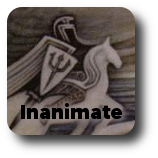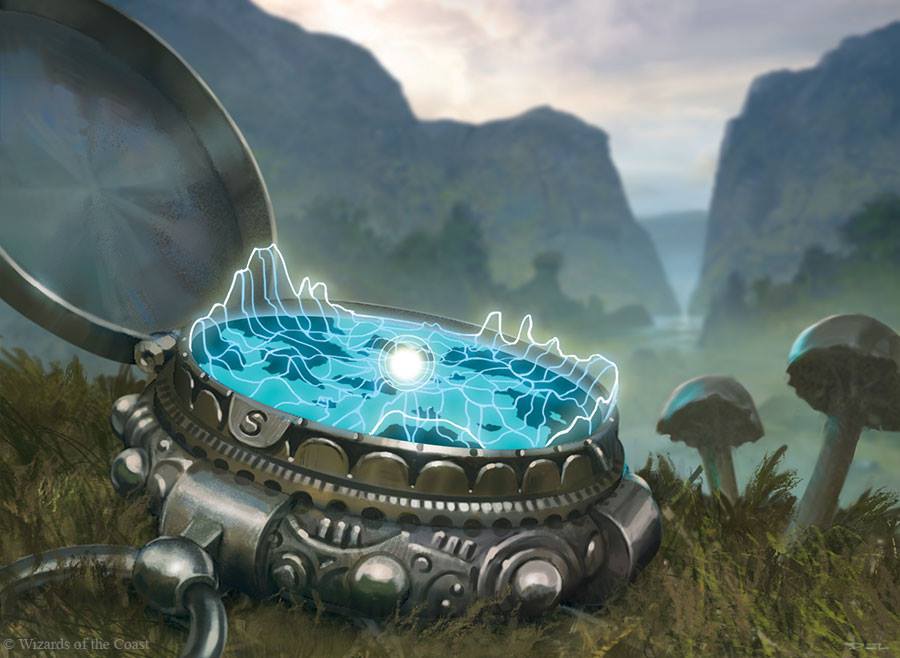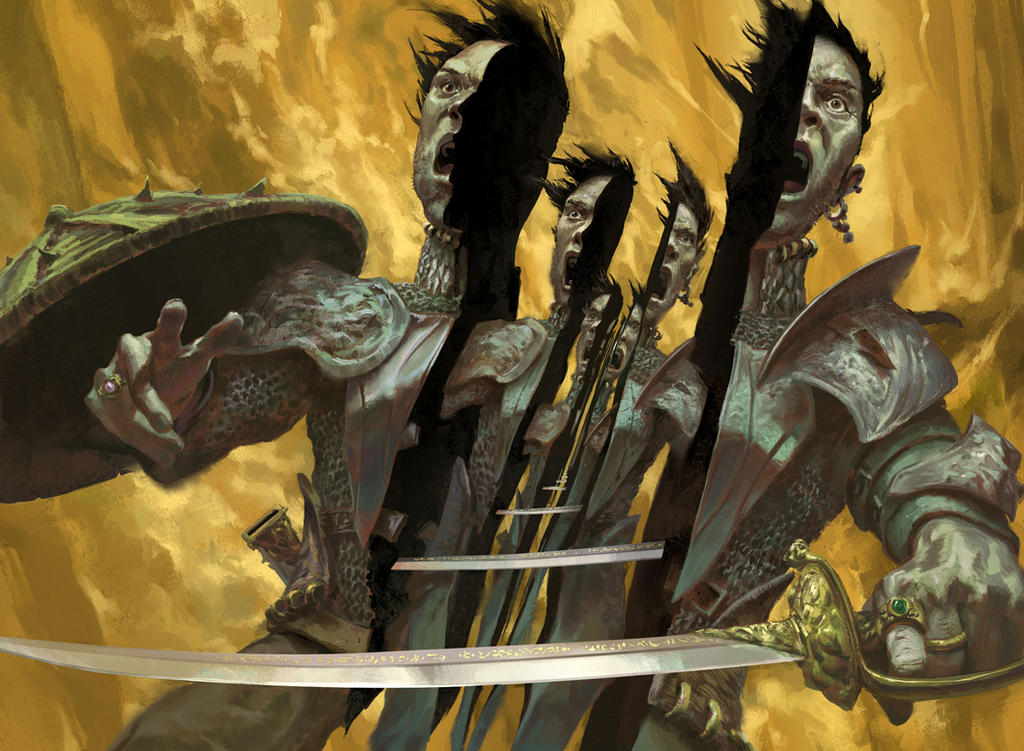 |
| This article is WotC safe. |
 |
| Cartographer by Donato Giancola |
This series, then, will be devoted to playtesting Limited - specifically, we'll be focusing on crafting an all-commons playtest, which is one of the most representative early playtests one can do for a set. While not truly representative of all of the set's archetypes- since it lacks build-around uncommons - and not truly representative of the set's playstyle - since it lacks the removal and 'bombs' that are generally kept in higher rarities - it will play similarly enough to true Limited that it's an approximate way to evaluate the set, and especially its mechanics.
Another big reason to playtest Limited is to playtest how mechanics work with deck construction. For example, the mechanic Devotion certainly plays out interestingly - it changes what cards you prioritze playing first - but it's most interesting as a mechanic when a player builds their deck around the mechanic, as it pushes them to include cards they otherwise wouldn't. A player normally would always play Great-Horn Krushok over Silent Artisan, but not so in a format with Devotion. This aspect of mechanics is not tested well in pre-Constructed decks - it's up to Limited to put this feature through its paces. There are other aspects of mechanics that can't properly be tested in a similar fashion.
 |
| Island by Chippy |
First off, there's the all-important set skeleton. A set skeleton is an extremely minimal overview of a set - it outlines the number of cards in each color at each rarity, and their ratios of creature to noncreature. This is very minimal, but it's certainly more than just a blank file! Now, we've reduced our requirement from 'more than 100 commons' to 'about 20 cards per color'. That's already sounding a lot better!
After this, let's look at the basic idea of archetypal designs. For an early initial playtest of mechanics it's not initially so important to worry about making each and every card accurately reflect a unique 'format' you're imagining - you can simply fill in many designs with archetypal designs, which are simple staple effects you see often. To see what kind of common effects are 'archetypal', I'd recommend looking to core sets for inspiration. This not only gives you a 'checklist' of some simple cards your set should have - an Unsummon variant, Shock variant, Giant Growth variant, a black defensive creature at CMC3, a red aggressive creature at CMC2, etc. - it also gives you a guideline for your format's mana curve. Making sure each color has well-distributed mana costs is important to making sure your playtest plays naturally. With archetypal designs, we've built a checklist, which gives us a lot more to work with than a blank set skeleton.
For the next two steps, we first have to identify what mechanics we want to use. Usually you'll want to pick out mechanics you feel are in need of more playtesting, or that you want to try an experiment with, and of course pick the mechanics you think are most likely to make it into the final set. As an example, here's my choices for the playtest I've been working on:
- Justice
- "Vehicle" mechanic
- Battle-Forged
- Revolution
- Envision
- "Thopters"
- "Canisters"
That's a pretty sizable list - normally a set wants to shoot for around 3 to 6 mechanics total, but as a playtest, we can err towards having more, to ensure we test as many mechanics as possible. For this playtest, 7 is a lot, but "Thopters" are more a theme than token. Now that we've gathered our list of mechanics, the next step is to figure out how often the mechanics appear at common.
For this step, let's look to the concept of as-fan. (As-fan, for those unaware, is 'how many of this card on average appear in a single booster pack?) For this, I'll be using the As-Fan Calculator, available online. It's a fantastic tool! Using this calculator, we can not only find the as-fan of our own mechanics, but - more importantly for our purposes - find the as-fan of mechanics in previous sets, giving us some valuable precedence to work off of. For this article, I'm breaking mechanics and themes into three very broad categories:
- Is your mechanic or theme essential to the set? For example, Allies in Battle for Zendikar, Morph in Khans of Tarkir, or Enchantments/Scry in Theros. If so, you should have an as-fan of about 2, and you should have around 12 to 18 cards at common of that mechanic or theme.
- An average mechanic/theme in an average set will have an as-fan of about 0.5 to 1. This means you want roughly 3 to 6 cards with that mechanic at common. If your set has five factions with the mechanics evenly distributed, tend towards the middle (4 or 5).
- If your mechanic is a 'feature' mechanic essential to multiple synergies - like Landfall in BFZ, or Flashback in Innistrad - bump that number up a bit, to about 8 to 10 cards at common, for an as-fan of 1 to 1.5.
We have one 'essential theme'. Kaladesh is a plane of artifice, so naturally we want a lot of artifacts! I want an as-fan of about 2.0 for this, so I'm going to just copy Khans of Tarkir's Morph count at common, and say we have 17 common artifact cards or cards that make artifact tokens.
We have seven mechanics. For now, I'm going to treat Revolution as a 'feature' mechanic, giving it 8 to 10 commons, and I'll be treating Envision as a mechanic similar to Scry, and also give it about 10. All other colors will get around 3 to 6 cards, leaning on the high end since this is a playtest, and the more cards we have with a mechanic in the file, the more chances we have to test it. Overall, that gives us more than a third of the set accounted for!
 |
| Surveyor's Scope by Daniel Ljunggren |
For the final step, it's time to look to the color distribution of our mechanics. Track which colors they appear in primarily, and which ones they appear in secondarily.
- Justice — White+Black primary, Blue secondary
- "Vehicle" mechanic — Artifacts only
- Battle-Forged — Black+Red primary, Green secondary
- Revolution — Red primary, Green+White secondary, Blue+Black tertiary
- Envision — Blue+Black primary, Green secondary, White+Red tertiary
- Thopters — Blue+Red primary, White secondary
- Canisters — Green+Blue primary, White+Red+Black tertiary
Astute readers who have been following Tesla will note that I've moved Justice to white and black primarily rather than white and blue, and moved Battle-Forged to black and red primariy. These are the 'experiments' I mentioned earlier. Why these choices? Well, this is one benefit of outlining the colors - when I did so, I realized black was lacking in mechanics, so I took a few steps to equalize the colors. It doesn't have to be perfect - this is a playtest, after all - but do try to keep the colors balanced.
Now, the big reason we've outlined the colors is to determine how many cards in each color get each mechanic. There's multiple ways to distribute mechanics. I'll give a few examples:
- For mechanics with a higher as-fan, give each color (primary or secondary) the same amount of cards with the mechanic, then give the primary colors one more. For example, we look to Magic Origins. Spell mastery was a five color mechanic, and each color got one card - then blue and black, the primary colors, got an additional. Renown was a three color mechanic, and each color got two - then the primary color, white, got one more.
- For mechanics with a lower as-fan, give only the primary colors a few cards each. For examples, Rebound in Rise of the Eldrazi only has one card in red and blue each, and Monstrosity in Theros only has one card in red and green each.
- Tertiary colors make these distributions more interesting, and require a combination of approaches. Typically, just take a 'tiered' approach. For example, let's look to Revolution - red gets three commons, green and white get two commons each, and blue and black get one each.
Now, let's put this all together, to get our final wrap-up of cards with mechanics we'll need to slot into our playtest file. For Tesla, it's the following:
- White: 3 Justice, 2 Revolution, 1 Envision, 1 Thopter, 1 Canister
- Blue: 2 Justice, 1 Revolution, 3 Envision, 2 Thopters, 2 Canister
- Black: 3 Justice, 2 Battle-Forged, 1 Revolution, 3 Envision, 1 Canister
- Red: 2 Battle-Forged, 3 Revolution, 1 Envision, 2 Thopters, 1 Canister
- Green: 1 Battle-Forged, 2 Revolution, 2 Envision, 2 Canister
- Artifacts or artifacts matter: 2 "Vehicle" artifacts, 6 more artifacts or artifacts matter cards
And there you have it! With that, we've accounted for a total of 52 cards, more than half the file! That's a fantastic start. And, even more helpfully, these 52 cards are split into many smaller checklists - it doesn't feel as insurmountable of a task to design 101 commons when you can design just a few at a time.
 |
| Infinite Obliteration by Yeong-Hao Han |
Well, just like how we've split set design into smaller pieces, so too have I opted to split this series of articles into three parts. Join us next time when we discuss the next part of this series: putting actual cards into the slots we've made!
Thanks for reading, and until next time, I wish you piece - I mean, peace, of mind. Have a great week!

Great overview!
ReplyDeleteA quick comment - not sure what revolution is doing in red really. Building up and then transforming (advancing) feels like a tough sell in red in general I guess.
Yeah, this is a good point that I considered myself. Personally, my thinking was that rebellion and resistance are unquestionably red concepts, so red was definitely going to be a major facet of revolution, at the very least. I decided to make red primary both because I feel like it's most fitting to the flavor of red, and because white was already doing very well mechanics-wise. (It had the most mechanics at the time.)
DeleteI agree that 'building up numbers' is white, but it's not un-red, ether. Red is about compassion just as much as it is about action - it's not out of the question for red to unify. 'Transforming' is in every color - change is a universal concept. Progress and growth are sought out by blue and green, but they're not out of the color pie for the other colors either.
Additionally, since white is the #1 token color, I figured putting Revolution in a color with less tokens would be interesting. Red gets Thopters in this set, but not much else. White gets a few thopters but a bunch of other things.